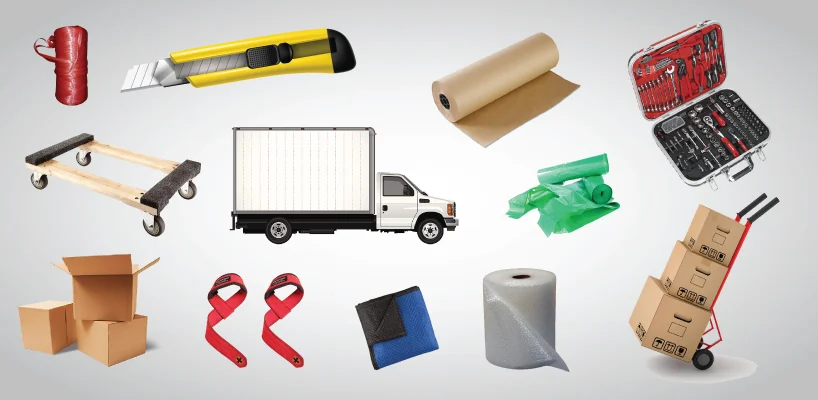Choosing the right school for your kids is like picking out the perfect pair of shoes—if they’re not a good fit, it’s going to be a rough walk ahead.
We know you’re probably thinking, "Oh great, more decisions to make on top of a big move!" But don’t worry. You're not alone in this.
According to a survey by the National Center for Education Statistics, nearly 1 in 10 kids in the U.S. change schools each year, and many of those kids are making that transition because of a family move.
And if you're moving to a new city or state with your kids, finding a good school when moving might feel like finding a needle in a haystack—especially when you’re juggling a thousand other things like packing and setting up utilities.
But it doesn’t have to be overwhelming. With the right planning, how to choose a school after relocating can actually be one of the most exciting parts of the move.
You'll just need to focus on a few key steps, and you’re done!
By the time you finish reading this guide, you’ll feel like a school-searching pro. We’ve got all the info you need in one place, so you don’t have to bounce around a million websites or ask 100 different people for advice.
Assess Your Child's Needs First
Before you start Googling schools and jumping into research mode, let’s take a step back. You don’t want to rush into choosing a school without thinking about what your kid actually needs.
Each child is different, and you need to figure out what kind of environment would be best for them.
Do they need extra support for learning?
Are they super into sports or art?
What are their social needs like?
Getting clear on these things will save you so much time in the long run.
So, what do you need to ask yourself?
- What kind of learning style does your kid have? Do they thrive in a quiet, focused environment, or are they more hands-on and creative?
- Do they have any special needs, like needing a learning support program or extra tutoring?
- Are extracurricular activities like sports, music, or theater a big deal to them?
- How important is the school's overall environment? Are you looking for a place with a strong sense of community or something with a more academic focus?
Once you figure out what your child needs, the next step is finding schools that fit those needs. This is actually the best place to start because it’ll save you from wandering aimlessly through all those school brochures.

Before you make that final decision, you might want to understand how moving schools can affect a child's development —it could change your perspective on the whole process!
Research Schools in Your New Area
Now, start researching schools! The first thing you should know is that you're not alone in this search.
There are so many online resources that can help you. You don't have to be a detective to find the information you need.
Start by looking at websites like GreatSchools, Niche, and SchoolDigger. These sites are loaded with ratings, reviews, and detailed information about every school in your area.
Here's what to look for:
- School ratings: GreatSchools will give you a school rating (on a 1 to 10 scale). Keep in mind that these ratings are important, but not everything—always read the reviews, too.
- School Reviews: Check out what other parents and students are saying. You might see patterns, like comments about the school's environment, the teachers, and the supportive staff
- Test scores: Look at things like standardized test scores to see how well the school is performing academically. But again, test scores are just one piece of the puzzle. Some schools do better in other areas that matter more to you, like creativity, character development, and school culture.
- School culture and environment: Read reviews about how friendly and welcoming the school is. Is it a place where kids feel safe and encouraged to be themselves? You want your child to be happy at school, so make sure the vibe matches what you’re looking for.
Note: Don't just rely on online ratings. Talk to locals if you can. Ask the neighbors, the real estate agent, or even your new coworkers if they have any school recommendations.

Don't let moving to stress you out! Compare movers in your area and make your transition smoother than ever.
Public vs. Private Schools – Understand the Difference
Now, let’s get into one of the big debates: public vs. private schools. Which one should you choose?
Both types have their pros and cons, and it really depends on your family’s situation and your child’s needs.
Public Schools
Public schools are funded by the government and are free to attend. They usually offer a wide range of programs and services.
However, public schools can vary in quality depending on where you live. Some are amazing, with excellent teachers and facilities, while others might not have the same resources.
Pros:
- Free education
- Often have more diversity in student populations
- Generally, a bigger selection of extracurricular activities
Cons:
- Larger class sizes (which can mean less individual attention)
- Budget limitations may affect resources or programs
- School ratings and reviews can vary a lot based on the district
Private Schools
Private schools, on the other hand, are not funded by the government, so they charge tuition (which can get pretty expensive—some private high schools can cost around $30,000 a year!).
However, many private schools have smaller class sizes, specialized programs, and access to additional resources.
Pros:
- Smaller class sizes (more one-on-one attention)
- Often offer specialized programs, like arts, music, or STEM
- More flexibility in curriculum design
Cons:
- Can be expensive—tuition is a big consideration here
- Not as diverse as public schools, in some cases
- You're limited to specific private school locations, so if you're in a new area, you might have fewer options.

Feeling overwhelmed by the move? Check out our tips on moving with kids to make the whole process a breeze!
School Catchment Areas
You’ve done your research, and now you’ve got your eye on a few schools.
But here’s a key thing you need to know: school catchment areas. These are the geographical areas around a school that determine who can attend that school.
When you're moving to a new place, check out the school boundaries. Some schools have a set catchment area, meaning only kids who live in a certain neighborhood or district can attend.
So, even if the school is your top choice, you might not be able to enroll your child unless you’re in the right area.
Check the local school district websites for detailed maps of school boundaries. Sometimes, you'll find that the school you love might be just outside of the boundary of your new home.
In this case, you might have to look at other schools within your catchment area, or you may even be able to apply for an exception.

Moving with kids? It's a big task! Download our moving checklist to keep everything on track and ensure nothing gets left behind.
The Enrollment Process – How to Register Your Kid
Once you’ve found the right school, the next step is enrolling your child. This can vary from school to school, but generally, you’ll need to:
Gather Required Documents
First, you’ll need to grab a few documents. These include:
- Proof of residence (this could be a utility bill, lease agreement, or mortgage statement to show that you live in the district).
- Your child’s birth certificate to verify their age.
- Immunization records: Schools want to ensure that the children are up to date on vaccines. If you're moving from out of state, check the local requirements, as some states have different rules.
Fill Out the Enrollment Forms
Most schools have enrollment forms available on their websites. Fill those out ahead of time to save time later. You'll provide basic info, like your child's name, grade level, and emergency contact details.
Submit the Paperwork
Now that you’ve got everything ready, it’s time to submit it. Depending on the school, you may be able to do this online or in person at the school office. Double-check that you've included everything on the checklist to avoid any delays.
Schedule a Meeting
Once the paperwork’s in, you may need to meet with a school counselor or principal, especially if your child is transferring mid-year. This meeting is a great opportunity to ask any questions you have and ensure a smooth transition for your child.
Wait for Confirmation
After everything is submitted, there’s a waiting period. The school enrollment process can take a couple of weeks, so don’t leave it until the last minute—get everything submitted early so your child is ready to start on time.

Looking for expert advice? Explore our moving guide, packed with tips and tricks to make your move as easy as pie.
Tips for Transferring Schools Mid-Year
What if you’re moving mid-year? Transferring schools during the middle of the school year can be tricky, but it’s not impossible.
Here are some tips:
Communicate Early with the School
The earlier you notify the school, the better. This gives them time to prepare, gather records, and set up a smooth transition for your child. If you're moving during the middle of the school year, some schools may have specific procedures, so give them a heads-up as soon as possible.
Prepare Your Child
Be upfront with your child about the move. Yes, it might be tough, but if you make them feel like they’re part of the process, it’ll be easier for them to adjust. Talk about what they can expect and emphasize the exciting parts (new friends, new activities, etc.).
Get Involved Quickly
Once your child settles in, it's time to get involved. Attend parent-teacher meetings, volunteer at school events, or join a school committee. The quicker you’re plugged into the school community, the more comfortable both you and your child will feel.
Ask About Support Services
Some schools offer additional resources for students transferring mid-year, like counseling or peer mentoring. Ask about any support programs they offer to help your child adjust to the new school environment.
Maintain Consistency at Home
Moving mid-year can disrupt routines, so try to keep other parts of your life stable. Stick to regular bedtime schedules, after-school activities, and family routines to give your child that sense of normalcy during the transition.
Encourage New Friendships
Encourage your child to participate in extracurricular activities or social clubs. This will not only help them make friends but also give them a sense of belonging in their new school.

Who doesn't love saving money? Get free, accurate moving quotes and find the best deals tailored to your needs.
Final Thoughts
After everything we've covered, you should have a clear picture of how to find a good school when moving. You know what to look for, how to research, and how to make the transition as smooth as possible.
Finding the best school districts for families is all about doing your research, keeping your child’s needs in mind, and making sure you follow the right steps in the school enrollment process after moving.
Recommended Resources















































 (239) 799–6077
(239) 799–6077